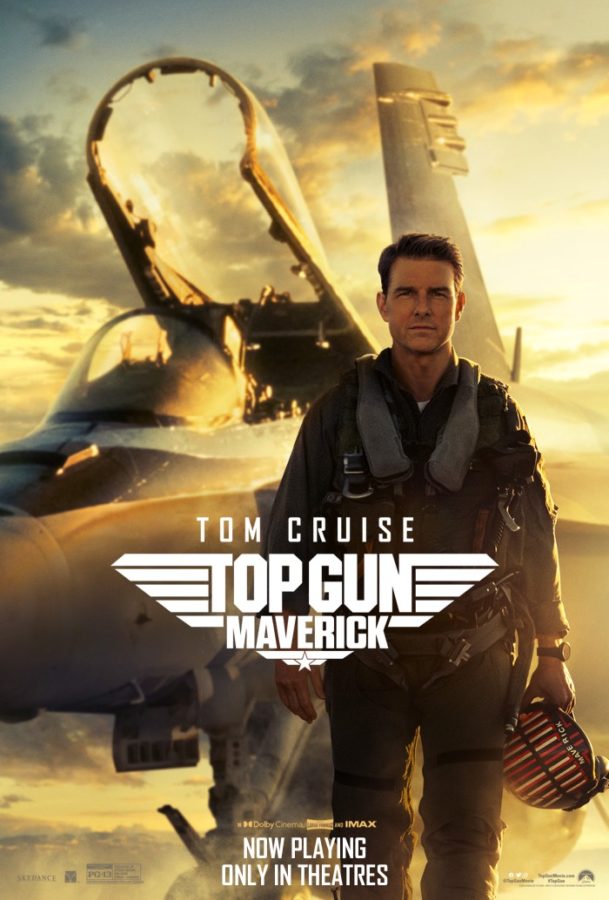Overcoming Hollywood’s nostalgia problem
Sequel attracts audiences, critics
Paramont Pictures Official Movie Poster
Tom Cruise returns to the screen for “Top Gun: Maverick,” the long-awaited sequel to the original movie. The movie creators do not rely on nostalgia alone to attrack audiences and critics to the new movie.
September 1, 2022
“Top Gun: Maverick” is the biggest movie of the summer.
According to Box Office Mojo, it’s made over a billion dollars worldwide and is outperforming other massive blockbusters such as “Doctor Strange in the Multiverse of Madness,” “Jurassic World: Dominion,” and “Minions: The Rise of Gru.”
The long-awaited sequel is a hit with critics and audiences alike. On Rotten Tomatoes, the movie is sitting at 96 percent from critics and 99 percent from fans.
How did the filmmakers manage to make a sequel loved by all ages, despite the original “Top Gun” coming out 36 years ago?
Many recent movies rely heavily on nostalgia. The newer Star Wars, Jurassic World, and Ghostbusters movies are prime examples of this.
In those movies, storylines are reused, characters return for little to no reason (and/or new characters are photocopies of original ones), settings are revisited, music is recycled, and entire sequences are sometimes repeated.
Whenever I see a new movie in one of my favorite franchises, I wonder: Do these nostalgic elements blind me to the fact that this isn’t a good movie? Would I enjoy this movie if I hadn’t grown up watching the previous installments?
Going into “Top Gun: Maverick,” I wondered if I would enjoy it. I knew the filmmakers wouldn’t be able to squeeze any nostalgia out of me.
I didn’t grow up watching the original “Top Gun.” In fact, the first time I watched it was a week before I saw the sequel.
After seeing the movie, I can say that “Top Gun: Maverick” does utilize some of those nostalgic elements I mentioned earlier. The movie references and repeats some of the most iconic aspects of its predecessor.
The opening credits sequence is almost an exact recreation of the one from the first movie, right down to Kenny Loggins’ “Danger Zone” playing in the background. In another scene, characters play football on the beach, mirroring the volleyball scene from the first movie.
However, in my opinion, the movie would still be enjoyable without those nostalgic elements (and I know this is true for me because those elements didn’t even spark any nostalgia in me).
Instead of solely banking on nostalgia to entertain audiences, the filmmakers behind “Top Gun: Maverick” crafted a genuinely great movie that anyone can enjoy.
Not only does it include jaw-dropping aerial stunts, but there are also genuine emotional stakes woven throughout the movie.
My favorite aspect of the first movie was the friendship between Maverick and Goose. If you’ve seen the original movie, you know that relationship couldn’t be continued in a sequel.
If “Top Gun: Maverick” took a page out of the most recent Star Wars movie’s book, Goose would appear out of nowhere and a character would remark, “Somehow, Goose returned,” with no further explanation.
Thankfully, they decided not to raise Goose from the dead in “Top Gun: Maverick.” Instead, they focus on the relationship between Maverick and Goose’s son, nicknamed Rooster.
Rooster had to grow up without a father, and he blames Maverick. You can see how this might spawn personal tension and some very powerful scenes.
The filmmakers could’ve been lazy. Of course, I was kidding earlier about bringing back Goose, but they could’ve tried replicating the Maverick/Goose relationship with copycat characters, for instance.
Instead, they built upon the former relationship, and they dealt with the ramifications of Goose’s death in a meaningful way.
I truly hope the success of “Top Gun: Maverick” makes Hollywood studios realize that audiences don’t just want to see the things they remember or watered-down versions of those things—they also want to see a compelling story with developed characters and powerful themes.
You can still catch “Top Gun: Maverick” in many theaters now, three months after its release.
If you haven’t seen the movie yet, I would highly recommend doing so.





